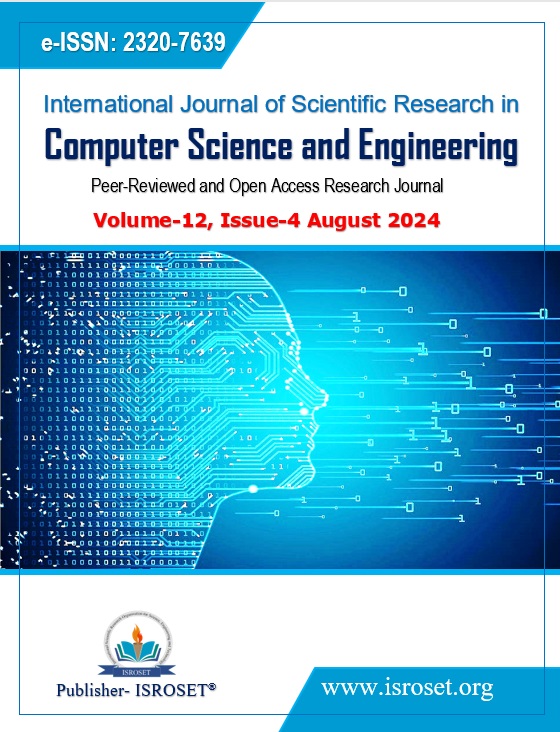Internet Protocol with Internet Programming (IP with IP): Architecture and Design
Keywords:
Internet Protocol (IP), Internet Programming, IPv4, IPv6, Type of Service, ProtocolAbstract
The Internet Protocol (IP) is a communication protocol utilized for inter-device communication on the Internet. It is a protocol at the network layer that furnishes an addressing system for uniquely identifying devices on the network and facilitating the routing of data packets between them. Conversely, Internet Programming pertains to the creation of applications and services that operate on the Internet. This encompasses activities such as web development, mobile app development, and other types of networked application development. IP is a crucial element of Internet programming because it establishes the underlying infrastructure for inter-device communication on the Internet. Internet programmers must possess a comprehensive understanding of IP and its associated protocols, like TCP (Transmission Control Protocol) and UDP (User Datagram Protocol), to construct applications that can communicate over the Internet. Additionally, internet programmers employ a variety of programming languages, frameworks, and tools to build applications that function on the Internet. This can incorporate languages such as JavaScript, Python, Ruby, and PHP, as well as web development frameworks like React, Angular, and Vue. In summary, IP and Internet programming are closely connected, as IP forms the basis for inter-device communication on the Internet, while Internet programming utilizes this foundation to develop a wide range of networked applications and services. In this article, we will elucidate the significance of both IP and internet programming as indispensable constituents of the Internet, demonstrating their close interconnection. IP establishes the groundwork for data transmission, while internet programming furnishes the means for creating and delivering web-based applications and services.
References
Sobin, “A survey on architecture, protocols and challenges in IoT”, Wireless Personal Communication, 1(12), pp 1383–1429, 2020
Seyed Mostafa Bozorgi, Mehdi Golaorkhtabaramiri Samaneh Yazdanid, “A Smart Optimizer Approach for Clustering Protocol in UAV-assisted IoT Wireless Networks”, Journal of Internet of Things; 2023
J. Chen, C. Touati, Q. Zhu, “Optimal Secure Two-layer IoT Network Design”, IEEE Transaction Control Networking Systems, 7(1), pp 398–409, 2020.
Andrew L. Russell, “Open standards and the digital age: history, ideology, and networks”, New York: Cambridge Univ Press. pp. 196, 2014.
Janet Abbate, “Inventing the Internet”, MIT Press, ISBN 978-0-262-51115-5, pp. 123–4, 2000.
Lin, Yi-Bing, Min-Zheng Shieh, "To Learn Programming through Internet of Things." IEEE Internet of Things Magazine 5, no. 4 (December 2022): pp.168–72, 2022
N. M. Garcia, P. P. Monteiro, M. M. Freire, “Burst assembly with real IPv4 data–performance assessment of three assembly algorithms,” in International Conference on Next Generation Wired/Wireless Networking, 2006, pp. 223–234, 2006.
Q. Wang et al., “Multimedia IoT systems and applications,” in 2017 Global Internetof Things Summit (GIoTS), 2017, pp. 1–6, 2017
S. Bj, “Can OTN be replaced by Ethernet? A network level comparison of OTN and Ethernet with a 5G perspective,” in 2018 International Conference on Optical Network Design and Modeling (ONDM), pp. 220–225, 2018
S. Zaman S., F. Karray. Fuzzy ESVDF approach for Intrusion Detection System. The IEEE 23rd International Conference on Advanced Information Networking and Applications (AINA-09). May 26-29, 2009.
I. Onut, A. Ghorbani. “A Feature Classification Scheme for Network Intrusion Detection”, International Journal of Network Security, pp.1-15,2007.
A. Tamilarasan, S. Mukkamala, A. Sung, K. Yendrapalli, “Feature Ranking and Selection for Intrusion Detection Using Artificial Neural Networks and Statistical Methods”, 2006 International Joint Conference on Neural Networks (IJCNN`06), pp.4754-4761, 2006.
A. Sung, S. Mukkamala, “Identifying Important Features for Intrusion Detection Using Support Vector Machines and Neural Networks”, Symposium on Application and Internet (SAINT`03), pp.209-216, 2003.
Amit Shukla, H.K. Application of robotics in offshore oil and gas industry—A review part II. Robot. Auton. Syst. 2015, 75, pp.508–524, 2015.
E. Brucherseifer, H. Winter, A. Mentges, M. Muehlhauser, M. Hellmann, “Digital Twin conceptual framework for improving critical infrastructure resilience”, pp.1062–1080, 2021.
P. Laplante, B. Amaba, “Artificial Intelligence in Critical Infrastructure Systems”, Computer 2021, 54, pp.14–24, 2021
Y. Wu, H.N. Dai, H. Wang, “Convergence of Blockchain and Edge Computing for Secure and Scalable IIoT Critical Infrastructures in Industry 4.0”, IEEE Internet Things J. 2020, 8, 2300–2317, 2020.
S. Park, S. Kwon, Y. Park, D. Kim, I. You, “Session Management for Security Systems in 5G Standalone Network”, IEEE Access 2022, 10, pp.73421–73436, 2022.
Downloads
Published
How to Cite
Issue
Section
License

This work is licensed under a Creative Commons Attribution 4.0 International License.
Authors contributing to this journal agree to publish their articles under the Creative Commons Attribution 4.0 International License, allowing third parties to share their work (copy, distribute, transmit) and to adapt it, under the condition that the authors are given credit and that in the event of reuse or distribution, the terms of this license are made clear.







